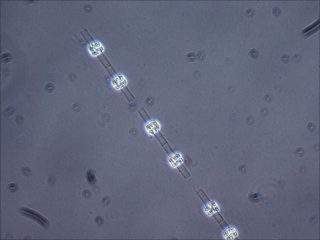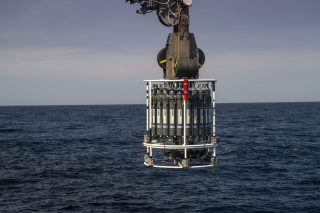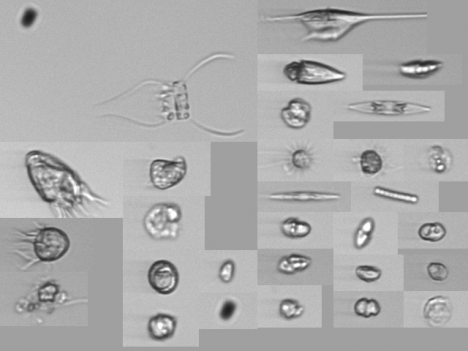Plankton comes from the greek word planktos, meaning wanderer. It does not define a specific organism, but rather a specific life style. Plankton consist of all organisms dispersed in water that are passively driven by water currents or are subject to passive sinking process. Some of those organisms have an ability to produce oxygen and sugars using sunlight and CO2, just like terrestrial plants do. We call them phytoplankton (greek: phyton -plant ).
Phytoplankton are the wandering meadows of the ocean and an important base of the food web. Most of the phytoplankton are smaller than the width of the single human hair. They are feeding the hungry ocean, and the phytoplankton composition determines the diversity of organisms developing on the higher trophic levels like fish, birds and mammals. It is not only important for organisms living in the ocean, but it is crucial for all life on Earth. Consider the size of the oceans covering our blue planet for a moment – the amount of phytoplankton every second breath that we take the oxygen is produced by phytoplankton.

This is microscopic picture of a diatom called Leptocylindrus, a kind of phytoplankton. Phytoplankton feeds the ocean, and the phytoplankton composition determines the diversity of organisms developing on the higher trophic levels like fish, birds, and mammals. Colleen Durkin
How To Begin?
When it comes to phytoplankton, it is not just the quantity, but also the quality that matters. You may wonder how can researchers sample something that we cannot see that exists in an environment where we cannot be in? How can we catch something that is passively driven by currents and changing all the time? How can we get the insight of the abundance of some particles that are unevenly dispersed in an ocean? Since the discovery of the microscope scientists have been trying to find answers to those questions.
Here, on R/V Falkor we are combining traditional methods of phytoplankton analysis – such as preservation of water for later, onshore analysis under a microscope – with the new, recently developed methods of onboard image analyses. Discrete samples are taken with the Niskin bottles at the specified depth. The sampling depth is chosen according to the physical, chemical and biological characteristics of the water column that are measured by the instruments mounted on the rosette, and controlled from the science control room. Once the rosette is on deck, the samples are taken from the Niskin bottles and prepared to be either stored until they return to land, or analyzed on board. The great advantage of the onboard image analysis is that it lends an instantaneous snapshot of the phytoplankton composition and abundance, which allows you to adapt your sampling strategy and use the time spent on the ship in a better, more productive way.

Discrete samples are taken with the Niskin bottles in each CTD cast, at specific depths. The sampling depth is chosen according to the physical, chemical, and biological characteristics of the water column. SOI/Mónika Naranjo González
The flow-through system onboard the R/V Falkor allows us for continuous sampling of the surface water for physical, chemical and biological properties, including phytoplankton composition with Imaging Flow Cytobot. This amazing instrument samples from the flow-through system every 20 minutes, and takes images of particles contained in 5 mL (100 drops) of seawater. Therefore, as we steam through the Pacific or as we stop to conduct some other measurements, we are continuously gathering high-spatial information about phytoplankton abundance and composition. The advantage of taking images vs. looking at the cells through the microscope is that you can always go back to your sample if needed. That helps us that help to have comparable results and minimizes the error of phytoplankton counting and taxonomy misidentification.

The Imaging Flow Cytobot is one of the state-of-the-art technologies used on the current expedition. As Falkor sails, a pump runs seawater through the instrument, which takes pictures of all the particles present. SOI/Ivona Cetinić
The Future….
Will the modern methods of high-resolution imaging ever substitute traditional microscopy? I would say – no. While continuous sampling techniques give us amazing insight into the spatial distribution of the phytoplankton and inform best sampling strategies, classical microscopy gives us insight into the detailed morphological characteristics that are needed to be seen from multiple angles to really be understood. The phytoplankton taxonomy is under constant revision and change as the new methodologies develop. With more knowledge and deeper insight, we do find answers to existing questions, but we also encounter more questions that need to be answered. The combination of the traditional and modern methods is the best strategy to understand the secrets of these beautiful oceanic wonders.
Tags: Carbon cycle, ocean science, phytoplankton, Sea to Space 2017



